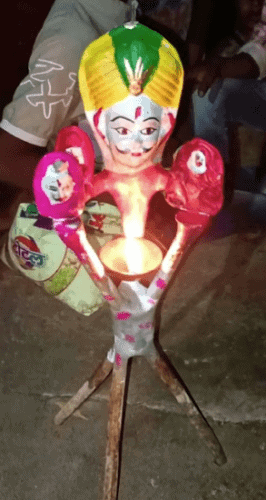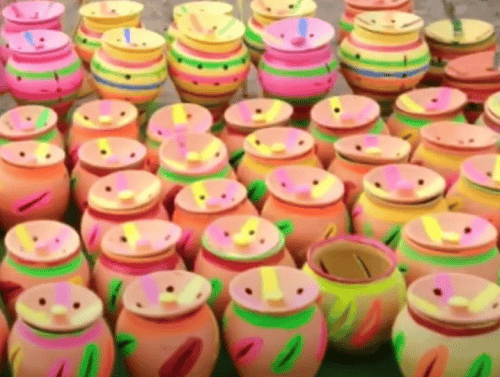Rooted in the epic saga of the Mahabharata, the Tesu and Jhanji rituals are not just celebrations; they are heartfelt connections to history and culture

Rituals in India are like a vibrant mosaic, each piece reflecting its people’s rich cultural heritage and diverse beliefs. Have you ever wondered why certain ceremonies occur or what hidden meanings they hold? From the lively celebrations of Diwali and Holi, filled with laughter and colour, to more intimate practices like the sacred thread ceremony (Janeu), every ritual is steeped in history and significance.
But there are also lesser-known rituals that often slip under the radar. For example, in some communities, quiet rites mark important life events, such as a child’s first haircut or special prayers during solar eclipses. These hidden rituals carry deep meanings, rooted in ancestral wisdom and spiritual beliefs, revealing the intricate layers of Indian culture.
Sadly, many of these beautiful traditions are fading. Urbanization and changing lifestyles have led to a decline in participation, especially among younger generations who might not fully grasp their significance. One such vibrant tradition is the Tesu and Jhanji rituals, which embody the essence of spring and the spirit of togetherness.
Once bustling with energy, these gatherings are becoming quieter, with fewer people joining in the joy of making these tesu dolls or singing Jhanji songs. So, let’s journey together through the enchanting world of the Tesu and Jhanji rituals and discover their beauty and meaning!
History of the Ritual– The Legends of Tesu and Jhanjhi
The tradition of the Tesu-Jhanji is rooted in a captivating story from the Hindu epic, the Mahabharata. At the heart of this tale is Barbarik (also known as Tesu), the grandson of Bhima and the son of Ghatotkacha. Known for his bravery, Barbarik learned the art of warfare from his mother and was so formidable that he claimed he could end the great war of the Mahabharata in just one minute if he fought alone. Lord Shiva, impressed by his prowess, gifted him three special arrows, while Lord Agni, the God of Fire, provided him with a unique bow.
Eager to witness the epic battle, Barbarik sought his mother’s permission to attend, promising he would fight for the weaker side if he participated. As he made his way to the battlefield, Krishna, intrigued by Barbarik’s reputation, disguised himself as a Brahmin to test his strength. When Krishna asked how long it would take Barbarik to finish the war solo, he confidently replied it would only take a minute. This astonished Krishna, especially since Barbarik was armed with just three arrows.
Barbarik then explained the extraordinary powers of his arrows. The first would mark everything he wanted to destroy, the second would identify what he wished to save, and the third would eliminate all marked by the first or unmarked by the second—after which, the arrows would return to his quiver. To demonstrate, Krishna challenged Barbarik to tie all the leaves from the tree they were standing under.
As Barbarik concentrated, Krishna slyly placed a leaf under his foot. When Barbarik released the first arrow, it marked all the leaves, including the one hidden by Krishna’s toe. Realizing this, Barbarik understood that Krishna was hiding something, and when Krishna lifted his foot, the arrow marked that leaf too.
Astonished by Barbarik’s abilities, Krishna recognized that his presence could tip the balance of the war. He explained that by promising to support the weaker side, Barbarik had unwittingly created a dilemma—whichever side he joined would become stronger, leading to the destruction of the other. To prevent this, Krishna, still in disguise, requested Barbarik’s head as a charitable offering. Though shocked, Barbarik agreed, provided that his two wishes would be granted: to witness the war and to marry the beautiful Jhanji.
With a heavy heart, Barbarik allowed Krishna to sever his head. Krishna then took it to Kurukshetra, placing it on three poles so that Barbarik could watch the battle unfold. His sacrifice also ensured that he would be united with Jhanji. This poignant story is commemorated each year on Sharad Purnima night, when the Tesu is symbolically married off to Jhanji in many homes, especially in Uttar Pradesh and Madhya Pradesh. It’s a beautiful reminder of love, sacrifice, and the enduring power of tradition.
Celebration of the Tesu and Jhanjhi Ritual
Tesu is a charming doll made of clay, standing on three legs to symbolize Barbarik’s head, which Krishna placed on three sticks so he could witness the epic Mahabharata war. You can recognize the doll by its playful laughing eyes and the paan-stained mouth. With a royal-looking moustache, Tesu holds a red parrot in one hand and a hookah in the other. It’s quite a striking figure! On the other hand, Jhanjhi is a colourful earthen pot, adorned with holes and lit from within by a candle or lamp. Isn’t that a beautiful image?

During the vibrant festival of Navratri, boys worship the Tesu for ten days, while girls honour the Jhanjhi, praying for a good husband. On the tenth day, known as Dussehra, the excitement reaches its peak. Children wrap the Tesu and Jhanjhi in a cloth and joyfully sing songs throughout the day visiting door to door. One of the famous verses that boys sing while holding the Tesu during this ritual goes:
“Mera Tesu, yahī ada, Khane ko maange dahi vada,
Sukh gaya mera Tesu re, Ek tang pe khada khada,
Mera Tesu, yahī ada, Khane ko maange dahi vada.”
This catchy tune adds to the festive spirit, celebrating the joy and traditions surrounding the Tesu! On Sharad Purnima night, a pandit “marries” the two, while women sing traditional ritual songs. Then, everyone gathers for a wedding feast under the beautiful moonlit sky. The houses are all decked out, creating a festive atmosphere for this special celebration! As a final farewell, they immerse both in a well, pond, or river, sending their wishes out into the world. It’s a delightful celebration filled with tradition, hope, and community spirit!
As we reflect on the rich tapestry of the Tesu and Jhanji rituals, it becomes clear that these celebrations are much more than mere customs; they are living connections to our heritage. By participating in these time-honoured practices, we actively contribute to the preservation of local traditions, ensuring they thrive for future generations. Have you ever joined in a ritual that made you feel part of something greater? It’s this shared experience that strengthens community bonds and fosters a profound sense of identity.
The younger generations, with their fresh perspectives and energy, play a crucial role in keeping these rituals vibrant, bridging the gap between past and present. So, let’s embrace these beautiful traditions, not just as observers, but as active participants in a cultural legacy that enriches our lives and brings us closer together. What rituals will you carry forward in your own journey?
FAQs about the Tesu and Jhanji rituals in India:
Q. What are the Tesu and Jhanji rituals? The Tesu and Jhanji rituals are traditional celebrations associated with local folklore, involving the making of Tesu dolls and singing Jhanji songs.
Q. What is the significance of Tesu dolls in the rituals? Tesu dolls are symbolic representations of a folk hero, made from clay. The dolls represent the strength and purity of Tesu, a figure tied to local mythology.
Q What role do Jhanji songs play in the celebrations? Jhanji songs are traditional folk songs that narrate the tales of Tesu and highlight themes of love, loss, and valour. Singing Jhanji songs is a way to engage communities in storytelling, preserving local history and folklore.
Q. How can these traditions be revived or preserved? Reviving Tesu and Jhanji rituals can be done through community festivals, school programs, and cultural initiatives that educate younger generations. Documentation, storytelling, and public performances can also help in preserving their legacy.
Q. Are there any specific times of the year when the Tesu and Jhanji rituals are performed? Yes, the Tesu and Jhanji rituals are primarily performed during the Sharad season, often coinciding with the Navratri celebrations ( generally in October).
Read more: Latest



